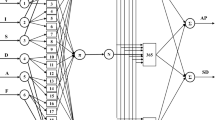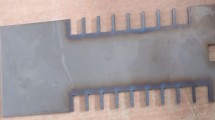Abstract
Submerged arc welding (SAW) is a widely used technique in various industries for welding thick plates. The quality of welded joints produced by this process depends on the selection of appropriate parameters that yield weldments with desirable mechanical properties. Among these parameters, weld bead penetration is a crucial indicator of weld quality. In this study, the effect of arc voltage, welding current, distance between the contact tip and the workpiece, and arc travel speed in the presence of Chromium oxide (Cr2O3) nanoparticles on penetration has been investigated. In addition, a new hybrid optimization algorithm has been developed by combining the differential evolution (DE) and wingsuit flying search (WFS) algorithms. The hybrid algorithm is evaluated by using standard benchmark functions and combined with the adaptive network-based fuzzy inference system (ANFIS) to create a new model. The model predicts weld bead penetration in the SAW process based on input parameters. The proposed hybrid algorithm improved the effectiveness of the main ANFIS in predicting weld bead penetration. The results showed that the addition of Cr2O3 nanoparticles to the weld pool increased its penetration.










Similar content being viewed by others
Data availability
All the data are provided in the paper.
Abbreviations
- ANFIS:
-
Adaptive network-based fuzzy inference system
- ANN:
-
Artificial neural network
- AI:
-
Artificial intelligence
- CCRD:
-
Central composite rotatable design
- DCEP:
-
Direct current electrode positive
- DE:
-
Differential algorithm
- DLS:
-
Dynamic light scattering
- EDX:
-
Energy dispersive X-ray
- FA-ACO:
-
Firefly algorithm-ant colony optimization
- FA-DE:
-
Firefly algorithm-differential evolution
- FIS:
-
Fuzzy Inference System
- GD:
-
Gradient descent
- GWO:
-
Grey Wolf Optimization
- LSE:
-
Least squares estimation
- MRE:
-
Mean Relative Error
- R2 :
-
Correlation determination
- RSW:
-
Resistance spot welding
- SAW:
-
Submerged arc welding
- SEM:
-
Scanning electron microscope
- Std Dev:
-
Standard deviation
- WFS:
-
Wingsuit Flying Search
References
Adak DK, Senapati D, Dutta P (2022) Parameters optimisation for submerged arc welding of mild steel weld bead geometry using response surface methodology. J Mech Contin Math Sci 17(8):34–47
Akkas N, Karayel D, Ozkan SS, Oğur A, Topal B (2013) Modeling and analysis of the weld bead geometry in submerged arc welding by using adaptive neurofuzzy inference system. Math Probl Eng 2013:1–10
Anand K, Barik BK, Tamilmannan K, Sathiya P (2015) Artificial neural network modeling studies to predict the friction welding process parameters of Incoloy 800H joints. Eng Sci Technol Int J 18(3):394–407. https://doi.org/10.1016/j.jestch.2015.02.001
Avazkonandeh-Gharavol MH, Haddad-Sabzevar M, Haerian A (2009) Effect of chromium content on the microstructure and mechanical properties of multipass MMA, low alloy steel weld metal. J Mater Sci 44:186–197
Chandel RS, Seow HP, Cheong FL (1997) Effect of increasing deposition rate on the bead geometry of submerged arc welds. J Mater Proc Technol 72(1):124–128
Choudhary A, Kumar M, Unune DR (2019) Experimental investigation and optimization of weld bead characteristics during submerged arc welding of AISI 1023 steel. Defence Technol 15(1):72–82. https://doi.org/10.1016/j.dt.2018.08.004
Comet M, Pichot V, Siegert B, Fousson E, Mory J, Moitrier F, Spitzer D (2011) Preparation of Cr2O3 nanoparticles for superthermites by the detonation of an explosive nanocomposite material. J Nanopart Res 13(5):1961–1969
Covic N, Lacevic B (2020) Wingsuit flying search—a novel global optimization algorithm. IEEE Access 8:53883–53900. https://doi.org/10.1109/ACCESS.2020.2981196
Dhas JER, Lewise KAS, Laxmi G (2022) Submerged arc welding process parameter prediction using predictive modeling techniques. Mater Today: Proc 64:402–409. https://doi.org/10.1016/j.matpr.2022.04.757
Foorginejad A, Azargoman M, Mollayi N, Taheri M (2020) Modeling of weld bead geometry using adaptive neuro-fuzzy inference system (ANFIS) in additive manufacturing. J Appl Comput Mech 6(1):160–170. https://doi.org/10.22055/jacm.2019.29077.1555
Gunaraj V, Murugan N (1999) Application of response surface methodology for predicting weld bead quality in submerged arc welding of pipes. J Mater Proc Technol 88(1):266–275
Heiple CR, Burgardt P (1985) Effects of SO2 shielding gas additions on GTA weld shape. Weld J Res Suppl 64(6):159s–162s
Heiple CR, Roper JR (1981) Effect of selenium on GTAW fusion zone geometry. Weld J 60(8):143S-145S
Heiple CR, Roper JR, Stagner RT, Aden RJ (1983) Surface active element effects on the shape of GTA, laser and electron beam welds. Weld J 62(3):72.S-77.S
Houldcroft PT (1990) Which process?: An introduction to welding and related processes and a guide to their selection. Woodhead Publishing
Jang J-SR (1993) ANFIS: adaptive-network-based fuzzy inference system. IEEE Trans Sys Man Cyber 23(3):665–685. https://doi.org/10.1109/21.256541
Jorge JCF, Souza LFG, Rebello JMA (2001) The effect of chromium on the microstructure/toughness relationship of C-Mn weld metal deposits. Mater Character 47(3):195–205
Kang DH, Lee HW (2012) Effect of different chromium additions on the microstructure and mechanical properties of multipass weld joint of duplex stainless steel. Metall Mater Trans A 43:4678–4687
Klimpel A, Kik T, Górka J, Czupryński A, Sitarz P (2009) SAW surfacing of low-alloyed steel with super-ferrite additional material. J Achiev Mater Manuf Eng 36(2):184–191
Kou S (2003) Welding metallurgy. Wiley
McCulloch WS, Pitts W (1943) A logical calculus of the ideas immanent in nervous activity. Bull Math Bio 5:115–133. https://doi.org/10.1007/BF02478259
Mirjalili S, Mirjalili SM, Lewis A (2014) Grey Wolf Optimizer. Adv Eng Soft 69:46–61. https://doi.org/10.1016/j.advengsoft.2013.12.007
Moghaddam MA, Kolahan F (2021) Modeling and optimization of A-GTAW process using back propagation neural network and heuristic algorithms. Int J Pressure Vessels Pip 194:104531
Montgomery DC (2017) Design and analysis of experiments, 6th edn. Wiley, New York
Moradpour MA, Hashemi SH, Khalili K (2015) Multi-objective optimization of welding parameters in submerged arc welding of API X65 steel plates. J Iron Steel Res Int 22(9):870–878
Naderian P, Aghakhani M, Heydarian K, Khoshboo S (2021) Effect of boehmite nanoparticles surface adsorbed with vanadium on the microstructure and hardness of the melted zone in the submerged arc welding process. J Eng Res Rep 21(11):1–10
Naderian P, Aghakhani M, Khoshboo S (2023) Modelling the hardness of weld metal in the submerged arc welding of low carbon steel plates: addition of CR2O3 nanoparticles. Adv Mater Proc Technol 9(1):221–236. https://doi.org/10.1080/2374068X.2022.2091186
Naseri H, Jahanbakhsh H, Foomajd A, Galustanian N, Karimi MM, Waygood DEO (2022) A newly developed hybrid method on pavement maintenance and rehabilitation optimization applying Whale Optimization Algorithm and random forest regression. Int J Pave Eng 24:1–13
Olson DL (1993) ASM handbook: welding, brazing, and soldering (Vol. 6). In: Asm Intl.
Rahmati F, Aghakhani M, Kolahan F (2023) Modeling and optimization of penetration depth using genetic algorithm, focusing on submerged arc Welding. In: 9th Int Conf Indust Sys Eng.
Rao R (2016) Jaya: A simple and new optimization algorithm for solving constrained and unconstrained optimization problems. Int J Ind Eng Comput 7:19–34. https://doi.org/10.5267/j.ijiec.2015.8.004
Rao RV, Rai DP (2017) Optimization of submerged arc welding process parameters using quasi-oppositional based Jaya algorithm. J Mech Sci Technol 31(5):2513–2522. https://doi.org/10.1007/s12206-017-0449-x
Rizk-Allah RM, Zaki EM, El-Sawy AA (2013) Hybridizing ant colony optimization with firefly algorithm for unconstrained optimization problems. App Math Comput 224:473–483. https://doi.org/10.1016/j.amc.2013.07.092
Saini S, Singh K (2023) Experimental investigations and optimization of weld bead characteristics during submerged arc welding using recycled steel slag as a flux. Proc Inst Mech Eng, Part E J Proc Mech Eng. https://doi.org/10.1177/09544089221150713
Saleem M, Lakshmanaswamy N (2022) Optimization of process parameters on weld bead characteristics of mild steel in submerged arc welding process. Mater Today Proc 62:1004–1010
Sarbazfard S, Jafarian A (2016) A hybrid algorithm based on firefly algorithm and differential evolution for global optimization. Int J Adv Comput Sci Appl 7(6):95–106. https://doi.org/10.14569/IJACSA.2016.070612
Sattarpanah Karganroudi S, Moradi M, Aghaee Attar M, Rasouli SA, Ghoreishi M, Lawrence J, Ibrahim H (2021) Experimental and numerical analysis on TIG arc welding of stainless steel using RSM APproach. Metals 11(10):1659
Shen S, Oguocha INA, Yannacopoulos S (2012) Effect of heat input on weld bead geometry of submerged arc welded ASTM A709 Grade 50 steel joints. J Mater Proc Technol 212(1):286–294
Shin Y, Darbon J, Karniadakis G E (2021) A caputo fractional derivative-based algorithm for optimization. ArXiv Preprint arXiv:2104.02259
Siva Kumar M, Rajamani D, Abouel Nasr E, Balasubramanian E, Mohamed H, Astarita A (2021) A hybrid approach of ANFIS—artificial bee colony algorithm for intelligent modeling and optimization of plasma arc cutting on Monel™ 400 Alloy. Mater 14(21):6373. https://doi.org/10.3390/ma14216373
Sridhar P, Biswas P, Mahanta P (2020) Effect of process parameters on bead geometry, tensile and microstructural properties of double-sided butt submerged arc welding of SS 304 austenitic stainless steel. J Braz Soc Mech Sci Eng 42(10):1–15. https://doi.org/10.1007/s40430-020-02636-4
Storn R, Price K (1997) Differential evolution—a simple and efficient heuristic for global optimization over continuous spaces. J Glob Opt 11(4):341–359. https://doi.org/10.1023/A:1008202821328
Surian E, Trotti J, Cassanelli A, De Vedia L (1994) Influence of chromium on the mechanical properties and microstructure of weld metal from a high strength SMA electrode. Weld J 73(3):45-s-53-s
Takagi T, Sugeno M (1993) Fuzzy identification of systems and its applications to modeling and control. Read Fuzzy Sets Intell Sys 15(1):387–403. https://doi.org/10.1016/B978-1-4832-1450-4.50045-6
Tarng YS, Yang WH, Juang SC (2000) The use of fuzzy logic in the Taguchi method for the optimisation of the submerged arc welding process. Int J Adv Manufg Technol 16(9):688–694
Zadeh LA (1965) Fuzzy sets. Inform Cont 8(3):338–353
Zaharuddin MFA, Kim D, Rhee S (2017) An ANFIS based approach for predicting the weld strength of resistance spot welding in artificial intelligence development. J Mech Sci Technol 31(11):5467–5476. https://doi.org/10.1007/s12206-017-1041-0
Funding
This research received no external funding.
Author information
Authors and Affiliations
Contributions
P.N. Conducting the experiments, writing the manuscript, developing model - A.K. Developing the model - M.A Supervising the research - H.G Preparing the nanoparticles - N.S. Conducting the experiments
Corresponding author
Ethics declarations
Conflicts of interest
The authors declare no conflict of interest.
Additional information
Publisher's Note
Springer Nature remains neutral with regard to jurisdictional claims in published maps and institutional affiliations.
Rights and permissions
Springer Nature or its licensor (e.g. a society or other partner) holds exclusive rights to this article under a publishing agreement with the author(s) or other rightsholder(s); author self-archiving of the accepted manuscript version of this article is solely governed by the terms of such publishing agreement and applicable law.
About this article
Cite this article
Naderian, P., Karami, A., Aghakhani, M. et al. Modeling the weld bead penetration in the presence of Cr2O3 nanoparticles in the submerged arc welding process using a modified neuro-fuzzy system. Multiscale and Multidiscip. Model. Exp. and Des. (2024). https://doi.org/10.1007/s41939-024-00386-7
Received:
Accepted:
Published:
DOI: https://doi.org/10.1007/s41939-024-00386-7




